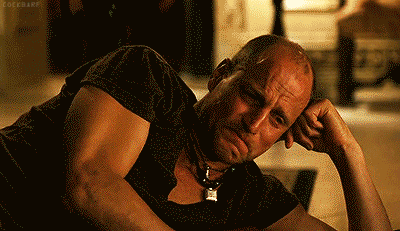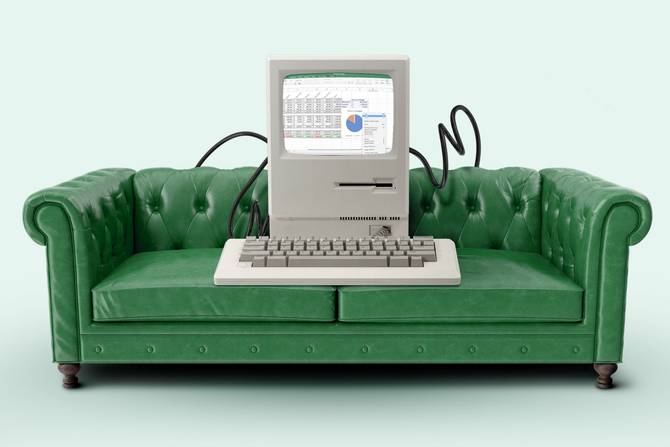Hello again! As HR Brew readers know all too well, recruiting is a game of constant adaptation. Join us on Thursday, March 2, at 12 pm ET for a virtual HR Brew event where we’ll talk about the future of recruiting and how companies can keep up. We’re speaking to Jocelyn S. Lai, global head of talent acquisition at Duolingo, about how the company approaches key recruiting questions, and her advice for HR leaders as they navigate the winding road of talent acquisition. Sign up here.
In today’s edition:
 We We are aren’t family
 Touchdown or fumble? Touchdown or fumble?
 Taking attendance Taking attendance
—Aman Kidwai, Kristen Parisi, Sam Blum
|
|
Zombieland/Columbia Pictures via Giphy
Can we finally retire the “We’re a family” description of a company’s culture?
Executives conducting recent tech layoffs have cited a variety of reasons: outsized expectations of pandemic recovery, economic headwinds, revenue-goal misses, or “a confluence of negative economic developments,” as Crypto.com’s CEO Kris Marszalek put it. But promoting a culture of unconditional, family-like loyalty has led to some laid-off employees feeling “betrayed.”
By referencing external forces, companies may have the cover, some have argued, to push workers to be less demanding, all while reducing labor costs. While this could be an attractive option for CEOs and CFOs looking at their business’ balance sheets, HR leaders may also consider how these actions may affect the company’s employment brand, employee morale, and talent strategy in the future.
Tech layoffs, explained. “We find that three characteristics are common to many of the companies that have recently announced a large number of layoffs,” Goldman Sachs chief economist Jan Hatzius wrote in a recent client note:
“First, many are in the technology sector. Second, many hired aggressively during the pandemic—on average, their headcount grew 41%—often because they over-extrapolated pandemic-related trends…Third, they have seen sharper declines in their stock prices, which have fallen 43% from their peaks on average, and in some cases appear to be responding to investor demand to cut costs by shrinking their workforces rather than to a worsening in the demand outlook.”
Shedding staff has led to a stock price resurgence at some large tech firms, like Alphabet, Microsoft, and Amazon. Jason Schloetzer, associate professor at Georgetown University’s McDonough School of Business, told HR Brew, that could have influenced other companies. Keep reading here.—AK
|
|
|
There’s somethin’ special just around the corner, and it’s set to bring your teams lots of good cheer. That’s right—we’re talkin’ about Employee Appreciation Day. And since it’s 2 weeks away, it’s time to set your sights on the here and now: your employees.
And Snappy can help. They make showing your team gratitude fun ’n easy with their simple and seamless gifting platform. Customize gift campaigns, organize recipients, and stick to your budget with powerful reporting tools and no surprise shipping fees.
After a quick and (best of all) FREE sign-up, Snappy can help you:
- access thousands of expertly curated gift choices
- delight your teams with magical gift reveals
- set up a gifting campaign in minutes
It’s no wonder that 41% of Fortune 100 companies use Snappy to boost employee wellness and morale.
Join the ranks and start showing your teams some TLC.
|
|
Workday
We know you only tuned into the Super Bowl for Rihanna and her surprise guest, but the night also featured some highly anticipated commercials. While consumer brands including Dunkin’, Google, and Uber came to play, the famous HR tech software Workday also took a pass.
Quick huddle. If you missed Workday’s ad, here’s the gist: Members of Kiss and other legendary rock stars come together to masterfully knock the tired notion of workplace “rock stars.”
“We know that using Workday for finance and HR makes you great at your job,” said Paul Stanley. “But that don’t make you a rock star,” added Gary Clark Jr.
Ozzy Osbourne even makes a cameo as a cubicle worker, clad in a shirt and tie.
Touchdown? Some HR leaders appeared to love the ad. Jeff Bettinger, a former CHRO who now owns a leadership coaching firm, leaned into the theme on LinkedIn, writing, “Workday, whoever created your ad is a rock star!”
Other HR professionals thought Workday fumbled. Some felt the $14 million Workday reportedly shelled out for 60 seconds of airtime would’ve been better spent on improving the product: “You’d think if Workday had that kind of money they’d be able to design a better online job application,” Adam Karpiak, who runs a recruiting consultancy, wrote on Twitter. His post was met with several replies echoing similar sentiments.
And less than two weeks after Workday laid off 400 employees, Jes Osrow, co-founder and fractional head of DE&I at HR consultancy The Rise Journey, commented on LinkedIn that it “leaves a bad taste in my mouth.”
One thing that can’t be denied: The ad had (rock) star power.—KP
|
|
The Office/NBCUniversal via Giphy
Is your office half full or half empty? Since the Covid-19 pandemic upended the steadfast nature of office attendance, many organizations have struggled to get employees back into that distant, foggy relic of an institution known as the corporate HQ.
Given the tug-of-war between companies beating the RTO drum and workers openly resisting it (perhaps by donning noise-canceling headphones?), we asked HR Brew readers about daily office attendance at their respective places of business. At the end of January, occupancy at offices in 10 major metro areas hit a post-pandemic milestone of 50%, according to research by security firm Kastle Systems.
Here’s what we learned in a recent HR Brew poll:
- 33% of readers have offices at 5–25% attendance.
- 25% of readers have offices at 25–50% attendance.
- 16% of readers have offices at 50–75% attendance.
- 26% of readers have offices at 75–100% attendance.
Certain leaders, such as venture capitalist Marc Andreessen, have pooh-poohed many aspects of remote work, while industry-leading employers like Airbnb have opted for a remote-first strategy. At the moment, it appears this clash of philosophies might endure.—SB
|
|
Today’s top HR reads.
Stat: Shopify claims it cut 320,000 hours of unnecessary meetings in one month by deleting 12,000 calendar events. (Bloomberg)
Quote: “People called me Sal for their ease because Selema sounded difficult or foreign to them…It grated my ears. Since I started insisting on Selema, I literally feel taller.”—Selema Masekela, a sports commentator, on the importance of being referred to by his full name at work (the Wall Street Journal)
Read: Workplace stress is nothing new, but Gen Z might be the most stressed generation of workers ever. (BBC Worklife)
Up close and personnel. The Georgetown Master’s in Human Resources Management prepares you to become an effective and strategic HR business partner. Attend a sample class, “Negotiation Skills and Strategies,” on March 7. Register now.*
*This is sponsored advertising content.
|
|
-
Tesla terminated dozens of employees at a Buffalo, New York, manufacturing facility that announced a union drive.
-
DocuSign, the e-signature company, is laying off 10% of its workforce, or around 700 employees.
-
Job-seekers are exploring ChatGPT as a tool for writing résumés and cover letters.
-
Ranking employees based on the value they bring to a company can crater morale, but the practice carries on at some tech companies.
|
|
Catch up on the top HR Brew stories from the recent past:
|
|
|







